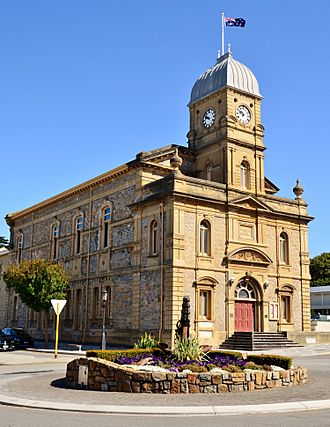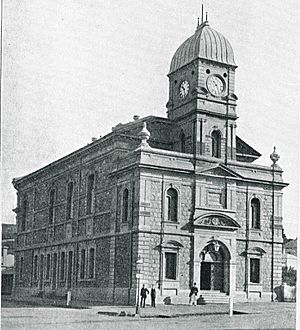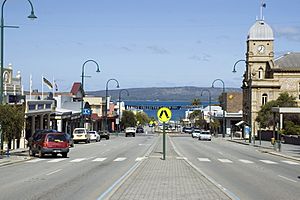Albany Town Hall (Western Australia) facts for kids
Quick facts for kids Albany Town Hall |
|
|---|---|

Albany Town Hall facing York Street
|
|
| General information | |
| Type | Town Hall |
| Location | Albany, Western Australia |
| Coordinates | 35°01′24.3″S 117°52′59.4″E / 35.023417°S 117.883167°E |
| Type | State Registered Place |
| Designated | 29 November 1996 |
| Reference no. | 74 |
The Albany Town Hall is an important public building located on York Street in Albany. This town is in the Great Southern region of Western Australia. It was the very first public building built in Albany.
Contents
About the Albany Town Hall
The Town Hall is a two-story building. It has a strong stone outside and a clock tower with four faces. You can find it on the corner of Grey Street West and York Street. This is right in the middle of Albany.
What Does the Building Look Like?
The building shows a style called Victorian Free Classical architecture. It was designed in 1886. An Adelaide firm, Henderson, Marriot and Company, created the plans.
The Town Hall is built from granite stone found nearby. It has fancy stucco decorations on the outside. Inside, the walls are plastered brickwork. The building has a ground floor, a first floor, and a gallery level. There are also more levels inside the tall clock tower.
The building is shaped like a rectangle. The clock tower stands right in the middle of the front. This makes it a very noticeable building on the street. The top of the tower has a copper roof and a flagpole.
What Was the Town Hall Used For?
When it first opened, the ground floor held offices for the town council. It also had some business offices. The public hall was on the first floor. This hall was a busy place. It hosted many cultural and community events. People came for theatre shows, movies, meetings, and dances.
History of the Town Hall
Plans for the Town Hall started in late 1882. The Albany Municipal Council decided to build it. They needed to borrow money for the project.
Choosing the Location
The Governor of Western Australia, William C. F. Robinson, helped the council. He offered them land to sell. This money would help them buy a good spot for the new building. They chose the current site on York Street.
In 1884, the building plans were ready. Builders were asked to submit bids for the construction.
Building the Hall
The foundation stone for the hall was laid in December 1886. The Mayor's wife, Mrs. W. G. Knight, did the honors. Many people came to watch. This included the architects and the builders.
The Town Hall officially opened on Foundation Day in 1888. The Mayor, William Grills Knight, opened it. A big celebration was planned. Bad weather stopped a parade. So, the keys were given to the Mayor on the steps. Later, a dinner for 60 people was held inside. A grand ball for 250 people followed that evening. Electric lights were put in the hall the next year.
The Town Hall clock was made by Potts of Leeds. It did not start working until April 1891.
Changes Over Time
In 1911, the first floor was often used as a movie theatre. New escape stairs were added in 1912. An upper gallery was built in 1913. This helped to add more seats for people.
New offices for the City of Albany were built in 1967. After this, the Town Hall was mainly used as a theatre. It also continued to host community events.
Protecting the Building
The building was recognized by the National Trust of Australia in 1977. It was added to the Register of the National Estate in 1978. This means it was seen as an important historical place.
By 1981, work began to turn the building into a theatre. This work finished in 1986. A concrete block was added to the back of the building. This covered some of the original stone. The clock face was also fixed. A bullet hole, from when soldiers came home from the Boer War, was patched up.
The building was officially listed on the State Register of Heritage Places in 1996. This protects its historical value.
The town square next to the Town Hall was updated in 2014. This was done for events. These events marked 100 years since ANZAC troops left for war.
Images for kids




